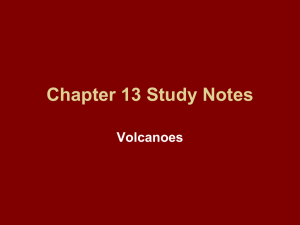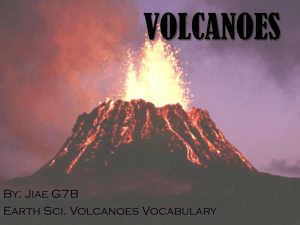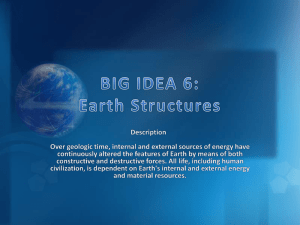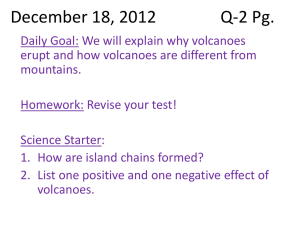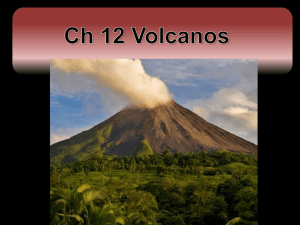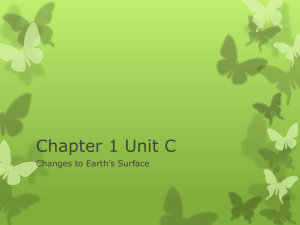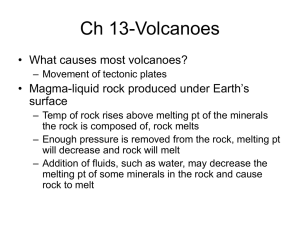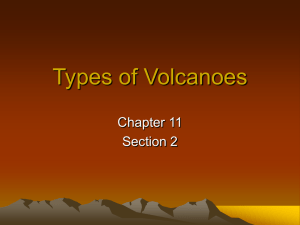Chapter 13 Power Point Notes
advertisement
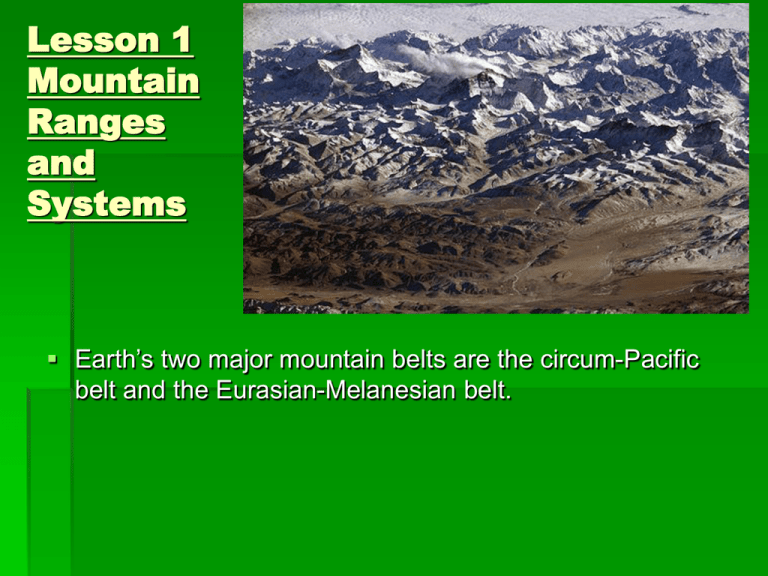
Lesson 1 Mountain Ranges and Systems Earth’s two major mountain belts are the circum-Pacific belt and the Eurasian-Melanesian belt. Where are the Mountain Belts The circum-Pacific belt forms a ring around the Pacific Ocean (a.k.a. – Ring of Fire) and includes: The Cascades (North Pacific) The Andes (South America) Where are the Mountain Belts The Eurasian-Melanesian belt runs from the Pacific islands through Asia and southern Europe and into northwestern Africa and includes: The Alps of Europe The Himalaya's of Asia Mt Baldy 10,000. Mt. Whitney 15,000, Mt. Everest 26,000 Mountains form as a result of collisions between tectonic plates at convergent boundaries. There are 3 types of boundaries in which these collisions happen and unique characteristics that go with each: Plate Tectonics and Mountains Check for Understanding What are the two major mountain belts and what mountains ranges are associated with each? How are mountains formed? Use your academic language. Write using complete sentences and proper grammar. Plate Tectonic s and Mountain s (1) Collisions between continents and oceanic crust Plate Tectonics and Mountain s (2) Collisions between oceanic crust Plate Tectonic s and Mountain s (3) Collisions between continents When oceanic lithosphere and continental lithosphere collide at convergent plate boundaries the denser oceanic lithosphere subducts beneath the continental lithosphere. This produces largescale deformation which uplifts high mountains. 1) Collisions between Continental & Oceanic Crust Also, the subduction of the oceanic lithosphere causes partial melting of the overlying mantle and crust. 1) Collisions between Continental & Oceanic Crust This melting produces volcanic mountains. Examples include the Cascades and Andes. 1) Collisions between Continental & Oceanic Crust Volcanic mountains commonly form where two plates whose edges consist of oceanic lithosphere collide. 2.) Collisions Between Oceanic Crust & Oceanic Crust In this collision, the denser, colder oceanic plate subducts beneath the other oceanic plate.. 2.) Collisions Between Oceanic Crust & Oceanic Crust Subduction again leads to volcanism and these eruptions of magma form an arc of volcanic mountains. Examples include the Philippine Islands Japan, New Zealand and Indonesia. 2.) Collisions Between Oceanic Crust & Oceanic Crust Mountains can also form when two continents collide. When the continental lithosphere of both plates collide, subduction is stopped because both plates have the same densities, the collision continues in a upward motion. 3.) Collisions Between Continents An example of this type of collision is the formation of the Alps in Europe and the Himalaya Mountains in Asia. 3.) Collisions Between Continents Collisions Between Continents The intense deformation that resulted from the collision uplifted the Himalaya’s, which are growing taller. Check for Understanding Draw the following: Draw the interaction between the Juan De Fuca Plate and the North American Plate. What type of plate collision is this interaction? Draw the Indian Plate and the Asian Plate collision. What type of collision is this interaction? Be sure to be clear and concise when identifying your plates. Label all pictures. Lesson 2 – Types of Mountains rockies 5:00 Scientists classify mountains according to the way in which the crust was deformed. Chapter 11 Four Types of Mountains (1) Folded Mountains Chapter 11 Types of Mountains (2) Fault-Block Mountains Chapter 11 Types of Mountains (3) Dome Mountains Chapter 11 NYIRAGONGO LAVA LAKE Types of Mountains (4) Volcanic Mountains Chapter 11 A folded mountain is a mountain that forms when rock layers are squeezed together and uplifted. The highest mountain ranges in the world consist of folded mountains that form when continents collide. Boundary type: Convergent 1. Folded Mountains The same stresses that form folded mountains also uplift plateaus. Arizona 1. Folded Mountains Plateaus are large, flat areas of rock, high above sea level and located near mountain ranges. Plateaus can form where large areas of rock are eroded or when a large portion of flat earth is pushed up from the earth. Plateaus A butte (French) is an isolated hill with steep, often vertical sides and a small, relatively flat top; it is smaller than mesas, and plateaus. Merrick Butte, Arizona Types of Plateau Butte Black Mesa, Arizona A mesa (Spanish – table) a flattopped mountain or hill. Types of PlateauMesa Fault-block mountains form when enormous underground pressure forces a whole rock mass to break away from another. Boundary Type: Transform or Divergent 2. Fault-Block Mountains On one side of this break the rocks rise; on the other side they sink down. Fault-Block Mountains Some of the most spectacular mountain scenery anywhere are the great rock walls of the Sierra Nevada which are actually the sides of huge tilted fault blocks. 2. Fault-Block Mountains The Sierra Nevada’s are in fact the broken upper edge of a huge plate that tilts down toward the west. 2. Fault-Block Mountains The same type of faulting that forms faultblock mountains also forms long, narrow valleys called grabens. Grabens Grabens develop when steep faults break the crust into blocks and one block slips downward relative to the surrounding blocks. Grabens Dome mountains are created when a large amount of magma pushes up from below the Earth’s crust, but it never actually reaches the surface and erupts. The pushed up rock (now metamorphic) cools and hardens into a dome shape. 3. Dome Mountains Chapter 11 Since the dome is higher than its surroundings, erosion works from the top creating a circular mountain range. Example of this is the Adirondack Mountains in N.Y. 3. Dome Mountains Chapter 11 3. Dome Mountains Another example is Half-Dome in Yosemite. Chapter 11 Volcanic mountains are created when magma from beneath the Earth makes its way to the surface. Krakatoa, Indonesia When it does get to the surface, the magma erupts as lava, ash, rock and volcanic gases. 4. Volcanic Mountains Chapter 11 This material builds up around the volcanic vent, building up a mountain over time. 4. Volcanic Mountains Chapter 11 The word comes from Spanish caldera, meaning "cooking pot." A Caldera is large, circular depression that forms when the magma chamber below a volcano partially empties and causes the ground above to sink Calderas - demo Eruptions that discharge large amounts of magma can also cause a caldera to form. •Crater Lake, Oregon Formed around 7,700 years ago by the collapse of the volcano Mount Mazama Calderas may later fill with water to form lakes. Calderas “Lahar" is an Indonesian word that describes volcanic mudflows or debris flows. Lahars have the consistency, viscosity and approximately the same density of concrete: fluid when moving, then solid when stopped. Lahars (Mudflows) Location of Volcanic Mountains Volcanoes can be found at these types of boundaries: (1) Convergent subduction plate boundaries (Cascades) (2) Divergent plate boundaries (MidAtlantic Ridge) (3) Hot spots (Hawaii) Highlights The cause of many volcanic eruptions is due to the movement of tectonic plates which is driven by Earth’s internal heat. Lesson 3 (Ch13) – Volcanoes Scientist on rim of Nyragongo 4:00 Chapter 13 Pressure and temperature increase as the depth below the earth's surface increases (heat from the core, pressure from overlying rocks, etc.). But, because pressure increases along with temperature, the rocks in the mantle remain solid. Chapter 13 Why does Rock Stay Solid For example, a rock's melting temperature on the surface might be 1000 ºC, but 200 km below the surface under much higher pressure, the melting temperature of the rock might be 1300 ºC. Why does Rock Stay Solid Chapter 13 So if overlying pressure changes then so does the melting point of the rock. Take the example of high altitude cooking. 1) Change in Pressure Chapter 13 Boiling Tea 1) Change in Pressure Chapter 13 The addition of water and volatile contents promote melting by lowering the melting temperature of rocks. Thus, a dry rock would have a higher melting point than a rock with water present. Chapter 13 2) Addition of Fluids Lastly increasing the temperature of a rock will also cause melting. 3) Increased Temperature Chapter 13 Magma is liquid rock produced under earth’s surface. Because magma is lighter then solid rock it flows upward away from denser rock and when it reaches the surface it is referred to as lava. Difference between Lava and Magma How explosive a volcano is depends on how runny or sticky the magma is. The viscosity, or resistance to flow, of magma affects the force with which a particular volcano will erupt. Viscosity Chapter 13 Because oxygen and silicon are by far the two most abundant elements in magma, it is convenient to describe the different magma types in terms of their silica content (SiO2). Types of Magma You can think of volcanoes in terms of when we get sick. Typically with a cold your nose is runny (mafic). However when you have the flu your mucus is thicker (felsic). Eruptions and the Cold Chapter 13 The amount of dissolved gas in the magma provides the driving force for explosive eruptions. The viscosity of the magma, however, is the most important factor in determining whether an eruption will be explosive or non-explosive. Gas Factor in Magma Mafic magmas, have relatively low silica and high iron (Fe) and magnesium (Mg) contents. Mafic volcanoes create a magma that is “Runny like honey”. Mafic Magma Oceanic volcanoes commonly form from mafic based magma. Because of mafic magma’s low viscosity (thin and runny), magma is hot (above 1700°F) and gases can easily escape from mafic magma. Chapter 13 Quiet Eruptions Eruptions from oceanic volcanoes, such as those in Hawaii, are referred to as quiet. Quiet Eruptions Chapter 13 Felsic magmas, have relatively high silica and low iron (Fe) and magnesium (Mg) contents. Felsic volcanoes create magma that is “Thicky like Skippy”. Felsic Magma Unlike the fluid lavas produced by oceanic volcanoes, the felsic lavas of continental volcanoes, such as Mount St. Helens, tend to be cooler (1400°F), thicker and stickier. If magma is thick and sticky (high viscosity), then gases cannot escape as easily. Explosive Eruptions Chapter 13 With felsic based lava pressure builds up until the gases escape violently and explode throwing pyroclastic material into the air. White Island, NZ Felsic volcanoes are the most dangerous and deadly. Explosive Eruptions Chapter 13 One of the most important warning signals of volcanic eruptions is an increase in earthquake activity around the volcano. Mt. St. Helens Predicting Volcanic Eruptions Warning sign #1 Earthquakes Also the geology may change due to swelling, subsidence and increased gas emissions. Predicting Volcanic Eruptions #2 Change in Mtn. Geology Predicting the eruption of a particular volcano also requires some knowledge of its previous eruptions. Just like the gap theory with earthquakes. Predicting Volcanic Eruptions #3 Using past eruptions Chapter 13 Mudflows (Lahars) went 17 miles into Columbia river Elevation was 9,700 ft now it is 8,400 ft Mount Rainier, (14,410 Feet) the highest volcano in the Cascade Range and is potentially the most dangerous volcano. Just outside Seattle Washington Chapter 13 Next United States Volcano is Mount Rainier is known to have erupted as recently as in the 1840s, and large eruptions took place as recently as about 1,000 and 2,300 years ago. Chapter 13 Mt. Rainier is considered the next threat in the U.S. Highlights Nyiragongo Nyiragongo scientist Like earthquakes, most active volcanoes occur in these 3 major zones: 1) Subduction Zones (convergent boundary) 2) Mid-Ocean Ridges (divergent boundary) 3) Hot Spots Chapter 13 Lesson 4 - Major Volcanic Zones The Ring of Fire is the largest subduction zone on Earth and is an area where large numbers of earthquakes and volcanic eruptions occur. The Ring of Fire has 452 volcanoes and is home to over 75% of the world's active and dormant volcanoes. The Ring of Fire At the Ring of Fire you will find collisions between oceanic and continental plates and collisions between oceanic and oceanic plates. Subduction Zones Volcanoes occur at a subduction zone because the subducting lithosphere brings down moisture and rock. The moisture lowers the melting point of the surrounding rock in the area which allows it to melt. Why do Volcanoes occur at Subduction Zones Because liquid rock (magma) is less dense then the solid rock around it, it rises to the surface of Earth. Why do Volcanoes occur at Subduction Zones Hot mantle rock rises where the plates are moving apart. This releases pressure on the mantle, which lowers its melting temperature. 2) Why do Volcanoes Occur Along Mid-Ocean Ridges & Divergent Boundaries Lava erupts through long cracks in the ground, or fissures. Most divergent volcanoes happen underwater and out of harms way of humans. 2) Mid-Ocean Ridges & Divergent Boundaries There are two exceptions and they are Iceland and Africa. Iceland is unique because ½ of Iceland is on the North American plate the other ½ is on the Eurasian plate allowing us to see how volcanoes work at divergent boundaries. Divergent Boundaries on Land - Iceland and Africa Chapter 13 Iceland is one of the most active volcanic regions in the world, with eruptions occurring on average roughly every three years (in the 20th century there were 39 volcanic eruptions on and around Iceland). Divergent Boundaries on Land - Iceland and Africa Chapter 13 Africa is another place where we get to witness volcanoes at a divergent boundary. There are 18 active volcanoes along with two unusual lava lakes. Divergent Boundaries on Land - Iceland and Africa Chapter 13 Example include volcanoes like: Erta Ale Nyiragongo Iceland and Africa Chapter 13 A Hot spot is a volcanically active area of Earth’s surface, commonly far from a tectonic plate boundary. This occurs because hot material called mantle plumes, rise and reach the lithosphere. 3) Hot Spots As magma rises to the surface, it breaks through the overlying crust creating a volcano. 3) Hot Spots Evidence suggests that mantle plumes stay stationary while the lithospheric plate above a mantle plume continues to drift slowly. So, the volcano on the surface is eventually carried away from the mantle plume. Chapter 13 Mantle Plumes The activity of the volcano stops because a hot spot that contains magma no longer feeds the volcano. However, a new volcano forms where the lithosphere has moved over the mantle plume. Chapter 13 Mantle Plumes Geologists have identified some 40–50 such hotspots around the globe, with Hawaii, Yellowstone, and the Galápagos, overlying the most currently active. Hot Spot Area’s Found on Earth Yellowston e Yellowstone Yellowstone Why these hot spots (plumes) occur is still disputed to this day by scientist. There are other theories out there including: 1) Crack in the Crust 2) Reheated slabs 3) Meteorite damage Why Hot Spots Occur In theory - Hot-spot volcanoes occur in long chains because they form along cracks in the Earth’s crust. These cracks come from weakness in the lithosphere caused by former ice sheets melting and their displacement of weight. 1st Theory – Cracks in the Crust (Earth’s Crust Displacement – ECD) Chapter 13 The reheated slab theory states that extra rock, through subduction is reintroduced into the mantle creating a plume of magma. 2nd Theory – Reheated Slabs Chapter 13 The meteor impact theory believes that foreign objects crashed into the Earth’s lithosphere damaging (puncturing) the rock and allowing magma to rise through to the surface. 3rd Theory – Meteorite impact Check for Understanding 1. Draw and describe how the Hawaiian Islands Formed. 2. Identify the 3 ways in which magma can reach the Earth’s surface. Provide evidence in which theory you believe to be most accurate. Volcanoes: The Eruptions, The Lava, and The Types Are all Eruptions Equal? • A quiet eruption • An explosive eruption Why are They Different • All magma is not equal • One key factor that controls whether or not an eruption is quiet or explosive is the amount of trapped gases and water vapor in the magma Types of Magmas - If gases can escape easily, the eruption is quiet. If the gas builds up high pressures, it eventually will cause an explosive eruption. - The more trapped water vapor in the magma, the more explosive the eruptions - The second factor is the amount of silica in the magma Quiet Eruptions • Some eruptions, are quiet, with lava slowly oozing from a vent. • Magma that is relatively low in silica and other fluids is called Basaltic magma and produces quiet eruptions like those on Kilauea (Hawaii) • Trapped gases and water vapor can easily escape sometimes forming lava fountains • Quiet eruptions occur over hot spots (Hawaii) and divergent boundaries (Iceland) Lava Fountain On Russian Island – Basaltic Lava Aloha Some volcanoes contain lava that can flow like a slow river. A volcano’s natural beauty will attract many visitors every year Where Lava Meets the Ocean New land is formed – Hawaii continues to grow Explosive Eruptions • Some eruptions are very violent, with lava and other materials being hurled hundreds of miles into the air. Gases from within the earth's interior mix with huge quantities of dust and ash and rise into the air as great, dark, poisonous clouds that can be seen from 100’s of miles away. • Andesitic magma has more silica than basaltic so it erupts more violently • Silica-rich or Granitic or Rhyolite magma produces explosive eruptions like those at Soufriere Hills volcano. • Rhyolite magma is thick and can trap gas and water vapor causing and buildup of pressure Images from Mt. St. Helens Photo taken early 1980 Present day Eruption could be felt and seen hundreds of miles away Buried in Ash and Mud Car buried in mud 17 miles away from Mt. St. Helens Escaping the ash on a beautiful afternoon in May This photo was taken 2 years after the eruption, this once great forest was still trying to recover Hot ash covered everything and traveled hundreds of miles Structure of an Eruption Pyroclastic Flow/Surge • Hot ash, embers, and poisonous gas • Maybe 1000 degrees Celsius • Moves very fast 100’s of meters per second • Moves with great force that has the ability to knock down trees and small buildings • Surge can bury, burn, and destroy everything in its path on impact. • In 1902, Mount Pelee’s surge killed 30,000 people Red Hot Pyroclastic Lightning Chile, South America Cloud with Shield Volcano • A shield volcano is broad with gently sloping sides and has quiet eruptions like those in Hawaii • Basaltic lava can also flow through large cracks called fissures forming flood basalts not volcanoes. • Underwater flood basalts are responsible for creating much of the new seafloor Cinder Cone Volcano • A cinder cone volcano has steep sides and is loosely packed • Its explosive eruptions throw lava and bits of rock high into the air • Bits of rock or solidified lava dropped from the air are called tephra which ranges in size from ash to large rocks Paricutin •On February 20, 1943, Paricutin, a cinder cone volcano, formed from the crevasse in a cornfield and grew to be several hundred meters tall in just a few days. This volcano continued to erupt for 9 years and grew to be over 1300 feet tall. •This gave modern scientists the opportunity to witness the birth of a volcano Composite Volcanoes “Stratovolcanoes” • Some volcanic eruptions can vary between quiet and explosive depending on the trapped gases and silica content. • Alternating layers of tephra and lava create a composite volcano • Composite volcanoes mostly occur at convergent boundaries • Grows to be the tallest volcanoes in the world Krakatau •In August of 1883, a composite volcano, Krakatau in Indonesia erupted with such force that the island it was on disappeared, killing more than 36,000 people. •It launched a series a Tsunamis that devastated the surrounding coastlines. •It affected the world’s weather and climate for a couple of years. Balsaltic Lava 3 types • • • A'a Pronounced "ah-ah", this is a basaltic lava that doesn't flow very quickly. It looks like a slowly moving mass of hot Jello, with cool but sharp, rough surface. Once it hardens, the sharp spiny surface of A'a lava is extremely difficult to walk across. These types of lava erupts at temperatures above 1000 to 1100 degrees C. Pahoehoe Pronounced "pa-ho-ho", this type of lava is much thinner and less viscous than A'a. It can flow down the slopes of a volcano in vast rivers. The surface of the lava hardens into a thin crust that looks very smooth. Pahoehoe lava can also form lava tubes, where the rock hardens around a fast-moving liquid core. When that core flows out of the tube, a long tunnel remains. Pahoehoe erupts at temperatures of 1100 to 1200 C. Pillow Lava Pillow lava is typically found erupting from underwater volcano vents. As soon as the lava contacts the water, it's cooled down and forms a hardened shell. As more lava issues from the vent, the shell of lava cracks and more "pillows" come out of these cracks. ANDESITIC LAVA • Intermediate SiO2 content (between 52 and 63%) • Intermediate viscosity* (does not flow readily) • Andesite magma commonly erupts from stratovolcanoes as thick lava flows, some reaching several km in length. • Andesite magma can also generate strong explosive eruptions to form pyroclastic flows and surges and enormous eruption columns. • The word andesite is derived from the Andes Mountains, located along the western edge of South America, where andesite rock is common. • Andesite was the main rock type that erupted during the great Krakatau eruption of 1883. * Viscosity is the resistance to flow RHYOLITIC LAVA • • • • • Relatively high SiO2 content (above 68%) Relatively high viscosity (flows like wet concrete) Rhyolite can look very different, depending on how it erupts. Explosive eruptions of rhyolite create pumice, which is white and full of bubbles. Quieter eruptions of rhyolite often produce obsidian, which is bubble-free and black. Some of the United States' largest and most active calderas formed during eruption of rhyolitic magmas (for example, Yellowstone in Wyoming, Long Valley in California and Valles in New Mexico). Rhyolite often erupts explosively because its high silica content results in extremely high viscosity which hinders escape of bubbles. When bubbles form, they can cause the magma to explode, fragmenting the rock into pumice and tiny particles of volcanic ash.
